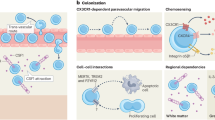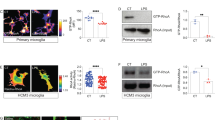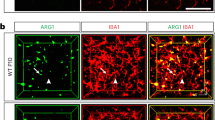Abstract
Cell motility drives many biological processes, including immune responses and embryonic development. In the brain, microglia are immune cells that survey and scavenge brain tissue using elaborate and motile cell processes. The motility of these processes is guided by the local release of chemoattractants. However, most microglial processes retract during prolonged brain injury or disease. This hallmark of brain inflammation remains unexplained. We identified a molecular pathway in mouse and human microglia that converted ATP-driven process extension into process retraction during inflammation. This chemotactic reversal was driven by upregulation of the A2A adenosine receptor coincident with P2Y12 downregulation. Thus, A2A receptor stimulation by adenosine, a breakdown product of extracellular ATP, caused activated microglia to assume their characteristic amoeboid morphology during brain inflammation. Our results indicate that purine nucleotides provide an opportunity for context-dependent shifts in receptor signaling. Thus, we reveal an unexpected chemotactic switch that generates a hallmark feature of CNS inflammation.
This is a preview of subscription content, access via your institution
Access options
Subscribe to this journal
Receive 12 print issues and online access
$209.00 per year
only $17.42 per issue
Buy this article
- Purchase on Springer Link
- Instant access to full article PDF
Prices may be subject to local taxes which are calculated during checkout








Similar content being viewed by others
References
Hanisch, U.K. & Kettenmann, H. Microglia: active sensor and versatile effector cells in the normal and pathologic brain. Nat. Neurosci. 10, 1387–1394 (2007).
Kreutzberg, G.W. Microglia: a sensor for pathological events in the CNS. Trends Neurosci. 19, 312–318 (1996).
Nimmerjahn, A., Kirchhoff, F. & Helmchen, F. Resting microglial cells are highly dynamic surveillants of brain parenchyma in vivo. Science 308, 1314–1318 (2005).
Davalos, D. et al. ATP mediates rapid microglial response to local brain injury in vivo. Nat. Neurosci. 8, 752–758 (2005).
Haynes, S.E. et al. The P2Y12 receptor regulates microglial activation by extracellular nucleotides. Nat. Neurosci. 9, 1512–1519 (2006).
Stence, N., Waite, M. & Dailey, M.E. Dynamics of microglial activation: a confocal time-lapse analysis in hippocampal slices. Glia 33, 256–266 (2001).
Block, M.L., Zecca, L. & Hong, J.S. Microglia-mediated neurotoxicity: uncovering the molecular mechanisms. Nat. Rev. Neurosci. 8, 57–69 (2007).
Jakob, A. Handbuch der Psychiatrie 1 (Aschaffenburg, G.) 268 (Deuticke, Vienna, 1927).
Nasu-Tada, K., Koizumi, S. & Inoue, K. Involvement of β1 integrin in microglial chemotaxis and proliferation on fibronectin: different regulations by ADP through PKA. Glia 52, 98–107 (2005).
Honda, S. et al. Extracellular ATP or ADP induce chemotaxis of cultured microglia through Gi/o-coupled P2Y receptors. J. Neurosci. 21, 1975–1982 (2001).
Wang, C.X. & Shuaib, A. Involvement of inflammatory cytokines in central nervous system injury. Prog. Neurobiol. 67, 161–172 (2002).
Nolte, C., Moller, T., Walter, T. & Kettenmann, H. Complement 5a controls motility of murine microglial cells in vitro via activation of an inhibitory G protein and the rearrangement of the actin cytoskeleton. Neuroscience 73, 1091–1107 (1996).
Möller, T., Kann, O., Verkhratsky, A. & Kettenmann, H. Activation of mouse microglial cells affects P2 receptor signaling. Brain Res. 853, 49–59 (2000).
Burridge, K. & Wennerberg, K. Rho and Rac take center stage. Cell 116, 167–179 (2004).
Mitchison, T.J. & Cramer, L.P. Actin-based cell motility and cell locomotion. Cell 84, 371–379 (1996).
Nagasawa, S.Y., Takuwa, N., Sugimoto, N., Mabuchi, H. & Takuwa, Y. Inhibition of Rac activation as a mechanism for regulation of actin cytoskeletal reorganization and cell motility by cAMP. Biochem. J. 385, 737–744 (2005).
Hashmi, A.Z. et al. Adenosine inhibits cytosolic calcium signals and chemotaxis in hepatic stellate cells. Am. J. Physiol. Gastrointest. Liver Physiol. 292, G395–G401 (2007).
Fredholm, B.B., IJzerman, A.P., Jacobson, K.A., Klotz, K.N. & Linden, J. International Union of Pharmacology. XXV. Nomenclature and classification of adenosine receptors. Pharmacol. Rev. 53, 527–552 (2001).
Ongini, E. & Fredholm, B.B. Pharmacology of adenosine A2A receptors. Trends Pharmacol. Sci. 17, 364–372 (1996).
Wittendorp, M.C. & Boddeke, H.W.G.M. & Biber, K. Adenosine A3 receptor–induced CCL2 synthesis in cultured mouse astrocytes. Glia 46, 410–418 (2004).
Angulo, E. et al. A1 adenosine receptors accumulate in neurodegenerative structures in Alzheimer's disease and mediate both amyloid precursor protein processing and tau phosphorylation and translocation. Brain Pathol. 13, 440–451 (2003).
Murphree, L.J., Sullivan, G.W., Marshall, M.A. & Linden, J. Lipopolysaccharide rapidly modifies adenosine receptor transcripts in murine and human macrophages: role of NF-kappaB in A(2A) adenosine receptor induction. Biochem. J. 391, 575–580 (2005).
Braun, N., Lenz, C., Gillardon, F., Zimmermann, M. & Zimmermann, H. Focal cerebral ischemia enhances glial expression of ecto-5′-nucleotidase. Brain Res. 766, 213–226 (1997).
Braun, N. et al. Assignment of ecto-nucleoside triphosphate diphosphohydrolase-1/cd39 expression to microglia and vasculature of the brain. Eur. J. Neurosci. 12, 4357–4366 (2000).
Schoen, S.W., Graeber, M.B. & Kreutzberg, G.W. 5′-Nucleotidase immunoreactivity of perineural microglia responding to rat facial nerve axotomy. Glia 6, 314–317 (1992).
Färber, K. et al. The ectonucleotidase cd39/ENTPDase1 modulates purinergic-mediated microglial migration. Glia 56, 331–341 (2008).
Rodríguez-Núñez, A. et al. Concentrations of nucleotides, nucleosides, purine bases, oxypurines, uric acid, and neuron-specific enolase in the cerebrospinal fluid of children with sepsis. J. Child Neurol. 16, 704–706 (2001).
Guthrie, P.B. et al. ATP released from astrocytes mediates glial calcium waves. J. Neurosci. 19, 520–528 (1999).
Koizumi, S., Fujishita, K., Tsuda, M., Shigemoto-Mogami, Y. & Inoue, K. Dynamic inhibition of excitatory synaptic transmission by astrocyte-derived ATP in hippocampal cultures. Proc. Natl. Acad. Sci. USA 100, 11023–11028 (2003).
Verderio, C. & Matteoli, M. ATP mediates calcium signaling between astrocytes and microglial cells: modulation by IFN-gamma. J. Immunol. 166, 6383–6391 (2001).
Pedata, F., Corsi, C., Melani, A., Bordoni, F. & Latini, S. Adenosine extracellular brain concentrations and role of A2A receptors in ischemia. Ann. NY Acad. Sci. 939, 74–84 (2001).
Tomozawa, Y., Yabuuchi, K., Inoue, T. & Satoh, M. Participation of cAMP and cAMP-dependent protein kinase in beta-adrenoceptor–mediated interleukin-1 beta mRNA induction in cultured microglia. Neurosci. Res. 22, 399–409 (1995).
Zhang, B. et al. Suppressive effects of phosphodiesterase type IV inhibitors on rat cultured microglial cells: comparison with other types of cAMP-elevating agents. Neuropharmacology 42, 262–269 (2002).
Min, K.J., Yang, M.S., Jou, I. & Joe, E.H. Protein kinase A mediates microglial activation induced by plasminogen and gangliosides. Exp. Mol. Med. 36, 461–467 (2004).
Schwarzschild, M.A., Agnati, L., Fuxe, K., Chen, J.F. & Morelli, M. Targeting adenosine A2A receptors in Parkinson's disease. Trends Neurosci. 29, 647–654 (2006).
Xu, K., Bastia, E. & Schwarzschild, M. Therapeutic potential of adenosine A(2A) receptor antagonism in Parkinson's disease. Pharmacol. Ther. 105, 267–310 (2005).
Popoli, P. et al. Functions, dysfunctions and possible therapeutic relevance of adenosine A2A receptors in Huntington's disease. Prog. Neurobiol. 81, 331–348 (2007).
Fiebich, B.L. et al. Cyclooxygenase 2 expression in rat microglia is induced by adenosine A2a receptors. Glia 18, 152–160 (1996).
Heese, K., Fiebich, B.L., Bauer, J. & Otten, U. Nerve growth factor (NGF) expression in rat microglia is induced by adenosine A2a receptors. Neurosci. Lett. 231, 83–86 (1997).
Küst, B.M., Biber, K., van Calker, D. & Gebicke-Haerter, P.J. Regulation of K+ channel mRNA expression by stimulation of adenosine A2a receptors in cultured rat microglia. Glia 25, 120–130 (1999).
Klegeris, A., Bissonnette, C.J. & McGeer, P.L. Modulation of human microglia and THP-1 cell toxicity by cytokines endogenous to the nervous system. Neurobiol. Aging 26, 673–682 (2005).
Bystrova, M.F., Yatzenko, Y.E., Fedorov, I.V., Rogachevskaja, O.A. & Kolesnikov, S.S. P2Y isoforms operative inmouse taste cells. Cell Tissue Res. 323, 377–382 (2006).
Bianco, F. et al. Pathophysiological roles of extracellular nucleotides in glial cells: differential expression of purinergic receptors in resting and activated microglia. Brain Res. Brain Res. Rev. 48, 144–156 (2005).
Hoskin, D.W., Butler, J.J., Drapeau, D., Haeryfar, S.M. & Blay, J. Adenosine acts through an A3 receptor to prevent the induction of murine anti-CD3–activated killer T cells. Int. J. Cancer 99, 386–395 (2002).
Grijelmo, C. et al. Proinvasive activity of BMP-7 through SMAD4/src-independent and ERK/Rac/JNK-dependent signaling pathways in colon cancer cells. Cell. Signal. 19, 1722–1732 (2007).
Chen, Y., Shukla, A., Namiki, S., Insel, P.A. & Junger, W.G. A putative osmoreceptor system that controls neutrophil function through the release of ATP, its conversion to adenosine, and activation of A2 adenosine and P2 receptors. J. Leukoc. Biol. 76, 245–253 (2004).
Feng, C., Mery, A.G., Beller, E.M., Favot, C. & Boyce, J.A. Adenine nucleotides inhibit cytokine generation by human mast cells through a Gs-coupled receptor. J. Immunol. 173, 7539–7547 (2004).
Kyrkanides, S. et al. Cyclooxygenase-2 modulates brain inflammation-related gene expression in central nervous system radiation injury. Brain Res. Mol. Brain Res. 104, 159–169 (2002).
Tha, K.K. et al. Changes in expression of proinflammatory cytokines IL-1beta, TNF-alpha and IL-6 in the brain of senescence accelerated mouse (SAM) P8. Brain Res. 885, 25–31 (2000).
Park, J.S., Woo, M.S., Kim, S.Y., Kim, W.K. & Kim, H.S. Repression of interferon-gamma-induced inducible nitric oxide synthase (iNOS) gene expression in microglia by sodium butyrate is mediated through specific inhibition of ERK signaling pathways. J. Neuroimmunol. 168, 56–64 (2005).
Acknowledgements
We thank B.D. Shur, R. Dingledine and J.M. Boss for discussions on the manuscript, J. Olson for assistance in the studies of human microglia, and E.R. Weeks and D. Semwogerere in the Emory University Department of Physics for useful discussions of image analysis techniques. We are also grateful to K.M. Vellano, A.G. Almonte and J.B. Revennaugh for excellent technical assistance with cell cultures, imaging equipment and animal maintenance. This work was supported by a US National Institutes of Health National Research Service Award fellowship to A.G.O., a pilot grant from the US National Institutes of Health (P01 ES016731), the National Parkinson's Foundation (S.F.T.) and US National Institutes of Health funding for S.F.T.
Author information
Authors and Affiliations
Contributions
A.G.O. designed and carried out the study, collected and analyzed data, and wrote the paper. A.L.O. helped carry out in vivo experiments, brain tissue processing and manuscript revisions. X.-J.L. provided surgical equipment and immunohistochemical reagents, R.E.G. provided human tissue samples and helped with experimental design and interpretation, and S.F.T. was involved in study design, interpretation of data and revision of the manuscript and figures.
Corresponding authors
Supplementary information
Supplementary Text and Figures
Supplementary Figures 1–6 (PDF 675 kb)
Supplementary Video 1
ATP repels LPS-treated microglia. Time-lapse three-dimensional reconstruction of a cultured LPS-activated mouse microglia migrating away from an ATP-filled micropipette positioned just beyond right edge of screen (pipette not shown). (MOV 1378 kb)
Supplementary Video 2
ATP induces process extension in untreated microglia. Time-lapse three-dimensional reconstruction of a mouse microglia exhibiting process extension toward the periphery of field during bath application of ATP. (MOV 1448 kb)
Supplementary Video 3
ATP induces process retraction in LPS-treated microglia. Time-lapse three-dimensional reconstruction of an LPS-activated mouse microglia exhibiting process retraction during bath application of ATP. (MOV 1371 kb)
Supplementary Video 4
ATP inhibits microglial process motion. Three-dimensional tracking (red traces) of cell processes of an LPS-activated mouse microglia. Bath application of ATP inhibited process motility. (MOV 1037 kb)
Supplementary Video 5
ATP attracts untreated human microglia. Cultured human microglia migrated toward and engulfed an ATP-filled micropipette at right. (MOV 5096 kb)
Supplementary Video 6
ATP repels LPS-treated human microglia. Cultured LPS-activated human microglia migrated away from an ATP-filled micropipette at right (pipette chases cell across field). (MOV 5700 kb)
Supplementary Video 7
Acute injury attracts untreated microglia in vitro. Untreated GFP-positive mouse microglia extended their processes toward acutely injured astrocytes. Mechanical injury (right edge) was induced with a micropipette at approximately 9 min (n = 3). (MOV 1323 kb)
Supplementary Video 8
Acute injury repels LPS-treated microglia in vitro. LPS-activated GFP-positive mouse microglia retracted its processes following astrocyte injury. Mechanical injury (right edge) was induced with a micropipette at approximately 8 min (n = 6). (MOV 1139 kb)
Rights and permissions
About this article
Cite this article
Orr, A., Orr, A., Li, XJ. et al. Adenosine A2A receptor mediates microglial process retraction. Nat Neurosci 12, 872–878 (2009). https://doi.org/10.1038/nn.2341
Received:
Accepted:
Published:
Issue Date:
DOI: https://doi.org/10.1038/nn.2341
This article is cited by
-
Gypenoside Pretreatment Alleviates the Cerebral Ischemia Injury via Inhibiting the Microglia-Mediated Neuroinflammation
Molecular Neurobiology (2024)
-
Cellular Prion Protein Attenuates OGD/R-Induced Damage by Skewing Microglia toward an Anti-inflammatory State via Enhanced and Prolonged Activation of Autophagy
Molecular Neurobiology (2023)
-
The role of the ATP-adenosine axis in ischemic stroke
Seminars in Immunopathology (2023)
-
TREM2 activation alleviates neural damage via Akt/CREB/BDNF signalling after traumatic brain injury in mice
Journal of Neuroinflammation (2022)
-
Caffeine and Its Neuroprotective Role in Ischemic Events: A Mechanism Dependent on Adenosine Receptors
Cellular and Molecular Neurobiology (2022)



